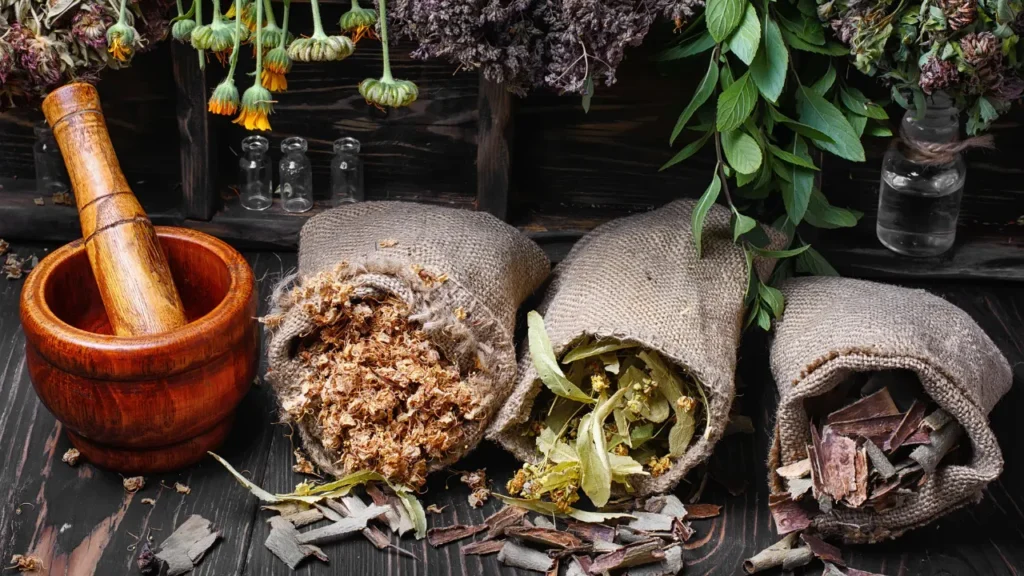The perennial herb known as yerba mansa, or Anemopsis californica, is indigenous to the southwest of the United States and northern Mexico. Native Americans have historically utilized it for various medical uses, such as treating skin conditions, digestive problems, and respiratory problems. Recent studies have shown yerba mansa’s potential health advantages, generating interest in its use as a dietary supplement. This article provides a comprehensive overview of yerba mansa’s nature, health advantages, recommended dosage, adverse effects, potential drug interactions, and responsible use as a nutritional supplement.
You May Also Like:
Diamond CBD Gummies vs. Joy Organics CBD Gummies
Sunmed CBD vs. Partnered Process CBD: Finding the Best CBD for Sleep
Yerba Mansa: Benefits, Dosage, Side Effects, Drug Interactions, And Other Important Information is an original (NootropicsPlanet) article.
Nature of Yerba Mansa
The perennial herb known as yerba mansa, or Anemopsis californica, is indigenous to the southwest of the United States and northern Mexico. It is a member of the Saururaceae family and is distinguished by its unusual cone-shaped inflorescence ringed by white bracts resembling petals. Native Americans have long utilized yerba mansa as a medicine to cure a variety of conditions, including respiratory problems, gastrointestinal problems, and skin conditions. The plant’s bioactive components, including essential oils, phenolic compounds, alkaloids, and polysaccharides, are principally responsible for its wide range of health advantages.
Health Benefits of Yerba Mansa
Initial Respiratory Health
Traditional uses of yerba mansa include treating cough, colds, and sinus congestion. The plant’s essential oils, which are abundant in substances like eucalyptol and thymol, have antibacterial and anti-inflammatory characteristics. Lowering inflammation and limiting the growth of pathogenic germs can help relieve respiratory symptoms.
Digestive Health
It has been demonstrated that the phenolic substances and alkaloids in yerba mansa have antispasmodic and anti-inflammatory properties, which can help improve the symptoms and discomfort of gastrointestinal disorders such as irritable bowel syndrome (IBS) and inflammatory bowel disease (IBD).
Skin Care
Traditional uses of yerba mansa include treating burns, rashes, and different skin diseases, such as wounds and burns. Thanks to its antibacterial and anti-inflammatory characteristics, it works well as a topical treatment for skin infections and inflammation. Additionally, yerba mansa’s antioxidant components may aid in accelerating skin healing and minimizing damage brought on by oxidative stress.

Chemistry of Yerba Mansa
The therapeutic qualities and overall health advantages of yerba mansa are attributed to the bioactive substances found in it. These substances consist of:
- Essential oils in yerba mansa have antibacterial, anti-inflammatory, and antioxidant activities. Compounds like eucalyptol and thymol, which have been found to reduce inflammation and limit the growth of harmful bacteria, are abundant in essential oils and have been shown to aid in relieving respiratory symptoms.
- Phenolic substances: Yerba mansa is a source of phenolic substances, including flavonoids and tannins, which support the plant’s anti-inflammatory and antioxidant properties. These substances reduce oxidative stress and inflammation, which are linked to a number of chronic diseases, by scavenging dangerous free radicals.
- Alkaloids: Yerba mansa contains alkaloids with various pharmacological qualities, such as analgesic and antispasmodic actions. These substances can help reduce symptoms and gastrointestinal discomfort brought on by diseases such as inflammatory bowel disease (IBD) and irritable bowel syndrome (IBS).
- Polysaccharides: The polysaccharides included in yerba mansa may have immunomodulatory effects. These substances can support a healthy immune system and body in general.
Physiological Mechanism of Action
The many bioactive chemicals found in the plant and their unique physiological modes of action on the body and brain are responsible for the health advantages of yerba mansa. Among these mechanisms are:
- Anti-inflammatory effects: Yerba mansa contains powerful anti-inflammatory chemicals and essential oils. These substances can reduce inflammation by preventing the generation of pro-inflammatory cytokines and regulating the activity of inflammatory enzymes like cyclooxygenase and lipoxygenase.
- Antioxidant activity: The flavonoids and tannins in yerba mansa, which are phenolic substances, work as antioxidants, scavenging damaging free radicals and shielding cells from oxidative stress-related cellular damage. This antioxidant action can help prevent chronic illnesses like cardiovascular disease, neurological diseases, and several cancer.
- Antibacterial qualities: The yerba mansa essential oils, which contain eucalyptol and thymol, have antibacterial qualities. These substances can prevent the development of harmful germs, including bacteria, fungi, and viruses, defending the body against infections and enhancing immune function.
- Antispasmodic effects: Yerba mansa’s alkaloids have been found to have antispasmodic effects. These substances can aid in relaxing the smooth muscle tissue in the gastrointestinal tract, easing symptoms of gastrointestinal diseases such as cramping and spasms.
- Analgesic qualities: Yerba mansa’s alkaloids may also be responsible for its analgesic benefits, which include reducing pain by interacting with the central and peripheral nerve systems. These substances can modulate the activity of numerous neurotransmitters and pain-related receptors, including opioid receptors and the release of endogenous opioids.
Researchers and healthcare practitioners can better examine the potential health advantages of yerba mansa as a dietary supplement and offer evidence-based recommendations for its use in diverse health scenarios by comprehending these physiological mechanisms of action.


Optimal Dosage of Yerba Mansa
Yerba mansa’s ideal dietary supplement dosage might change according to each person’s needs, health objectives, and tolerance. Most adults are generally believed to be safe and effective with daily consumption of 1-2 grams of dried yerba mansa root or 300-600 mg of a standardized extract. However, before beginning a new supplement regimen, people should speak with a healthcare provider, especially if they have a specific medical condition or are taking medication.
Side Effects of Yerba Mansa
Although yerba mansa is usually thought to be safe to consume, some people may experience adverse effects. GI discomfort, such as nausea, diarrhea, and stomach cramps, are typical adverse effects. Increasing yerba mansa intake gradually or lowering the dosage can frequently reduce these symptoms. Furthermore, people with allergies to plants in the Saururaceae family should use caution when taking yerba mansa supplements, as they can have adverse reactions.


Potential Substance Interactions with Yerba Mansa
Consideration should be given to several possible interactions between yerba mansa and different drugs or substances. These consist of:
- Anticoagulant and Antiplatelet Drugs: Yerba mansa may interact with blood-thinning drugs such as warfarin, clopidogrel, and aspirin. This interaction may increase the likelihood of bleeding and bruising. If you use an anticoagulant or antiplatelet medication, it is imperative to talk to a doctor before taking yerba mansa.
- Blood Pressure Drugs: Because yerba mansa can lower blood pressure, it may interact with blood pressure drugs and result in dangerously low blood pressure. Before using yerba mansa supplements, anyone taking blood pressure drugs should speak with a healthcare provider.
- Agents that Lower Blood Sugar: Yerba mansa may have hypoglycemic effects and interact with diabetes drugs. People with diabetes who take medication should constantly monitor their blood glucose levels and talk to a healthcare provider about any possible interactions.
Best Responsible Uses of Yerba Mansa
It’s crucial to take into account the following advice to ensure the optimum ethical use of yerba mansa as a nutritional supplement:
- Before beginning a new supplement regimen, speak with a medical practitioner, especially if you have existing health issues or are taking medication.
- Select yerba mansa supplements of the highest caliber from reliable suppliers who follow stringent quality control guidelines.
- Start with a modest dosage and gradually increase intake to determine tolerance and reduce potential adverse effects.
- Look for any adverse effects and get medical advice if they worsen.
Yerba Mansa:
Conclusion
Indigenous peoples have used yerba mansa for various purposes, including as a ceremonial herb, spiritual purification, and as a remedy for ailments ranging from infections to rheumatism. While traditional knowledge is valuable, scientific validation is necessary to understand and utilize yerba mansa’s full potential. Further scientific studies, including clinical trials, are needed to fully elucidate its mechanisms of action, efficacy, and safety profile. Individuals interested in using yerba mansa for medicinal purposes should consult with a healthcare professional for personalized guidance and recommendations.


References:
- Yerba Mansa (Anemopsis californica): A review of traditional uses, phytochemistry, and biological activities, and then link: https://www.sciencedirect.com/science/article/pii/S0378874114008385
- Anemopsis californica: A plant with potential use in phytotherapy, and then link: https://www.researchgate.net/publication/286454742_Anemopsis_californica_A_plant_with_potential_use_in_phytotherapy
- In vitro antimicrobial and anticancer activities of Anemopsis californica, and then link: https://www.tandfonline.com/doi/full/10.1080/14786419.2017.1342491
- The anti-inflammatory and analgesic activities of Anemopsis californica, and then link: https://link.springer.com/article/10.1007%2Fs11418-014-0836-0
- Antioxidant activity and phenolic content of Anemopsis californica, and then link: https://www.researchgate.net/publication/282359340_Antioxidant_activity_and_phenolic_content_of_Anemopsis_californica
Important Note: The information contained in this article is for general informational purposes only, and should not be construed as health or medical advice, nor is it intended to diagnose, prevent, treat, or cure any disease or health condition. Before embarking on any diet, fitness regimen, or program of nutritional supplementation, it is advisable to consult your healthcare professional in order to determine its safety and probable efficacy in terms of your individual state of health.
Regarding Nutritional Supplements Or Other Non-Prescription Health Products: If any nutritional supplements or other non-prescription health products are mentioned in the foregoing article, any claims or statements made about them have not been evaluated by the U.S. Food and Drug Administration, and such nutritional supplements or other health products are not intended to diagnose, treat, cure, or prevent any disease.
